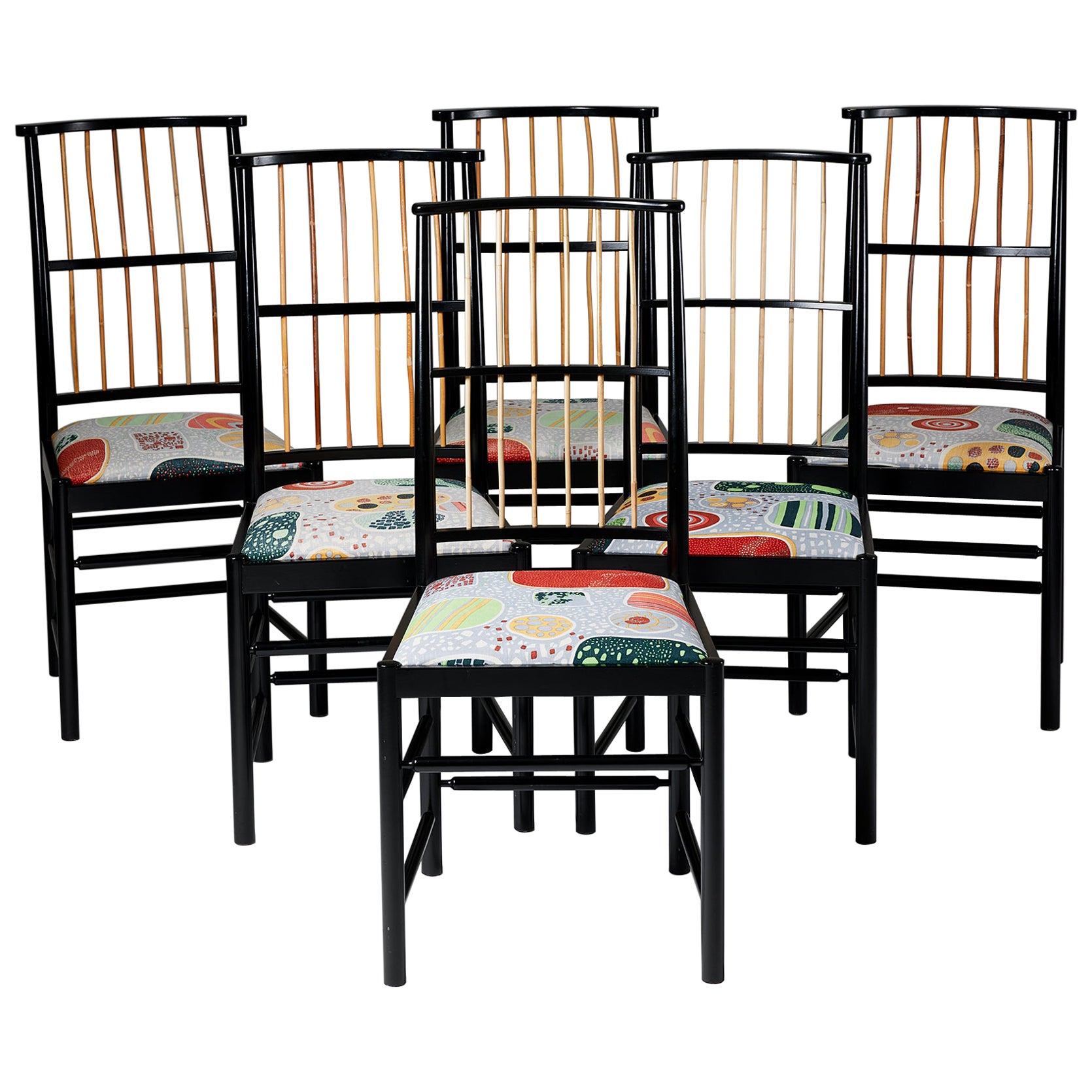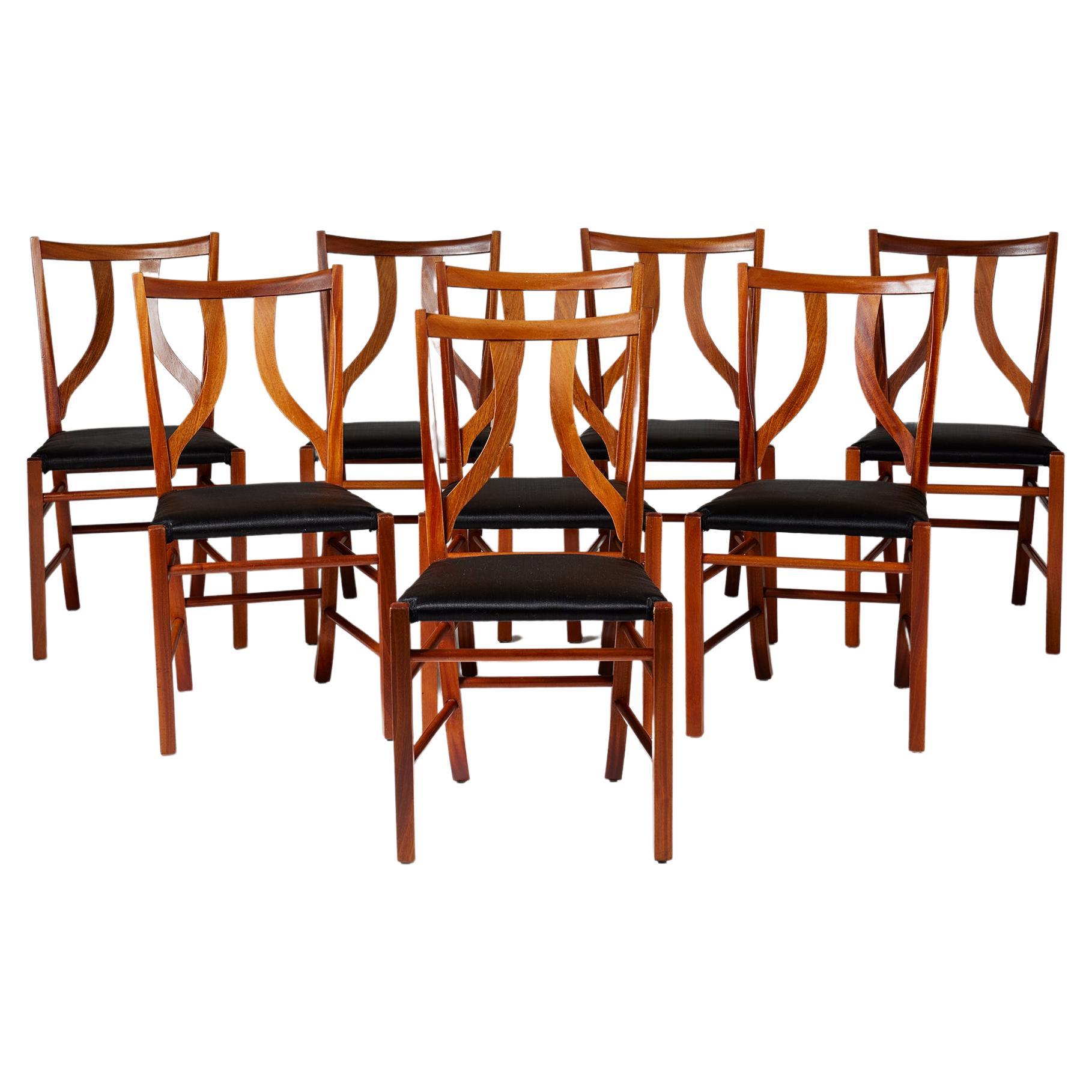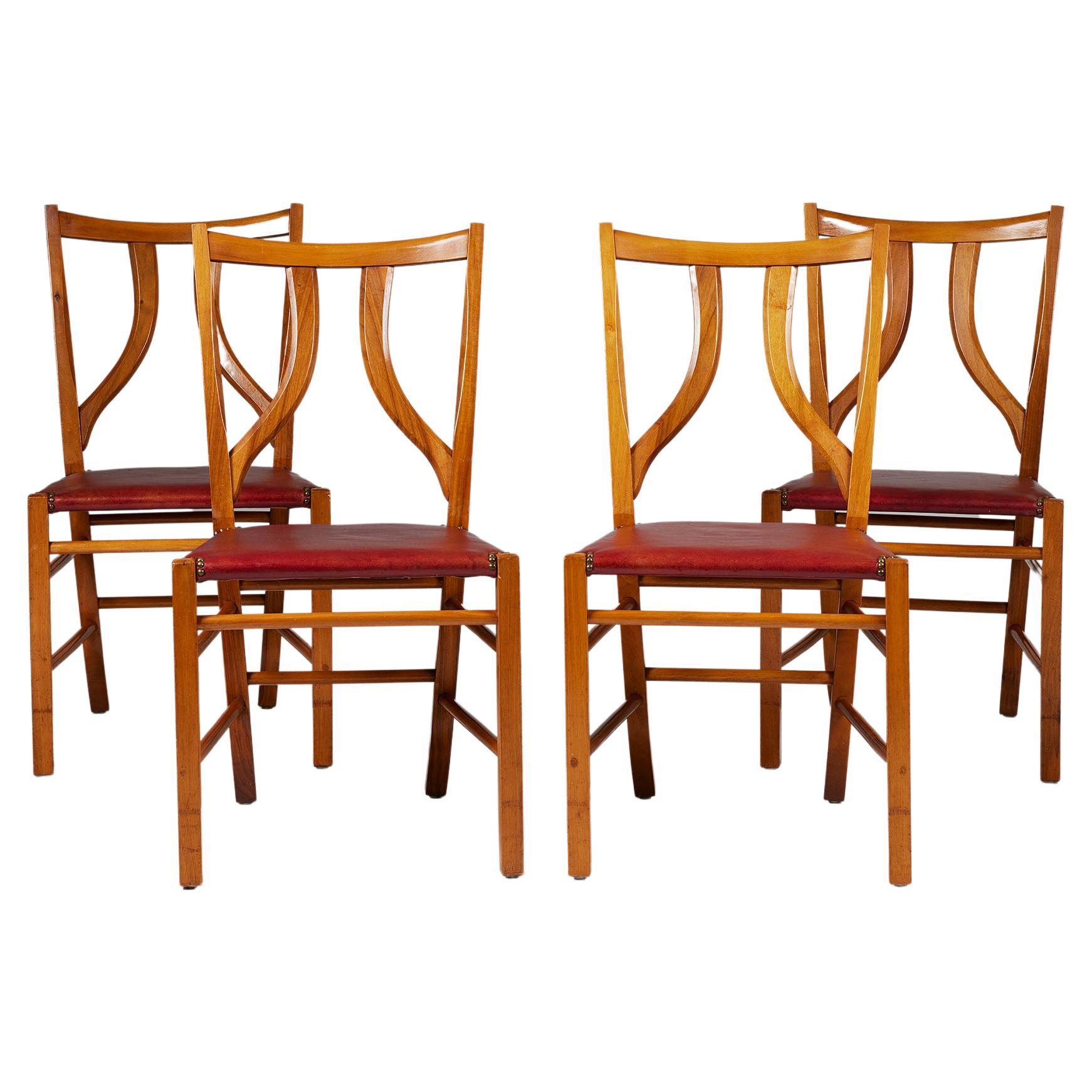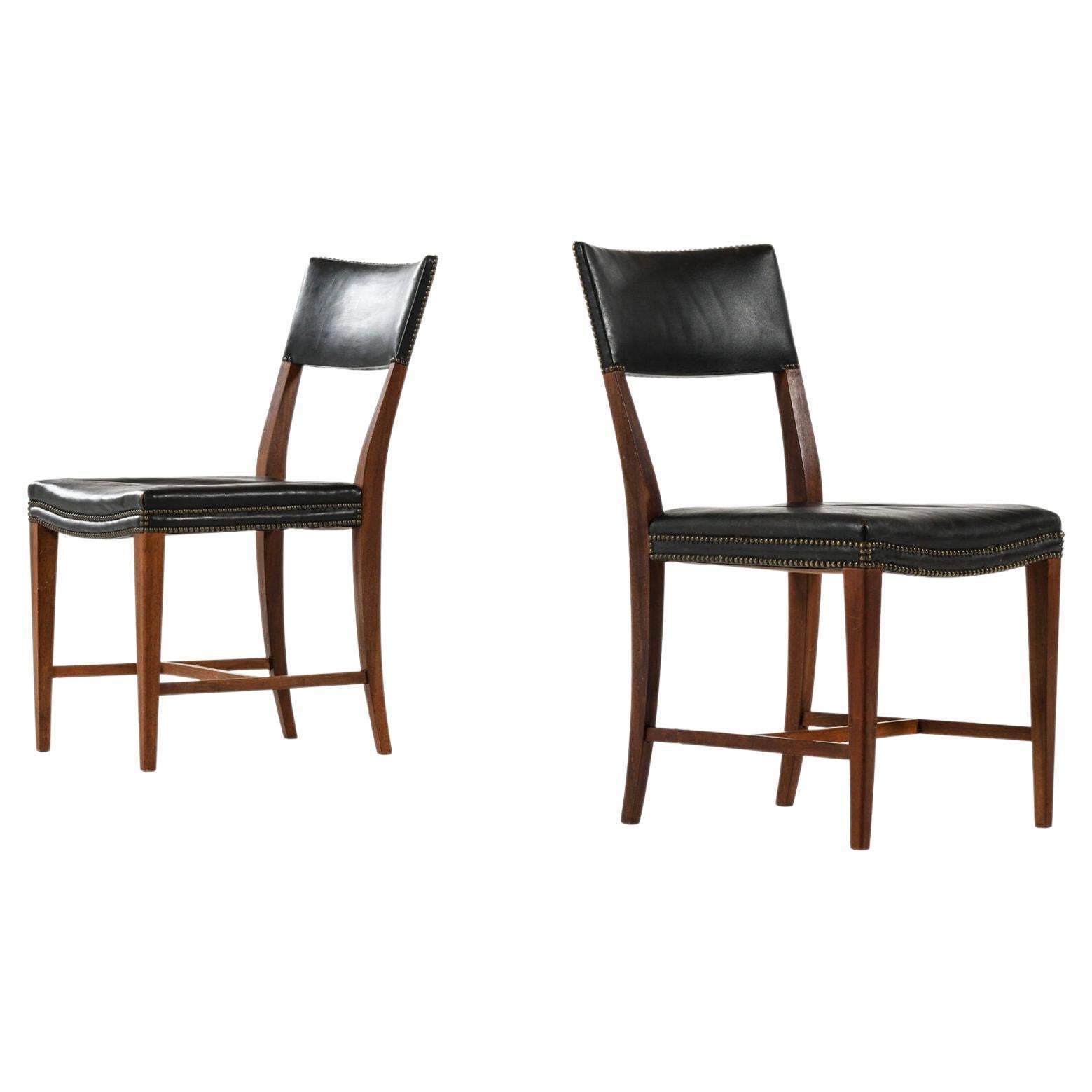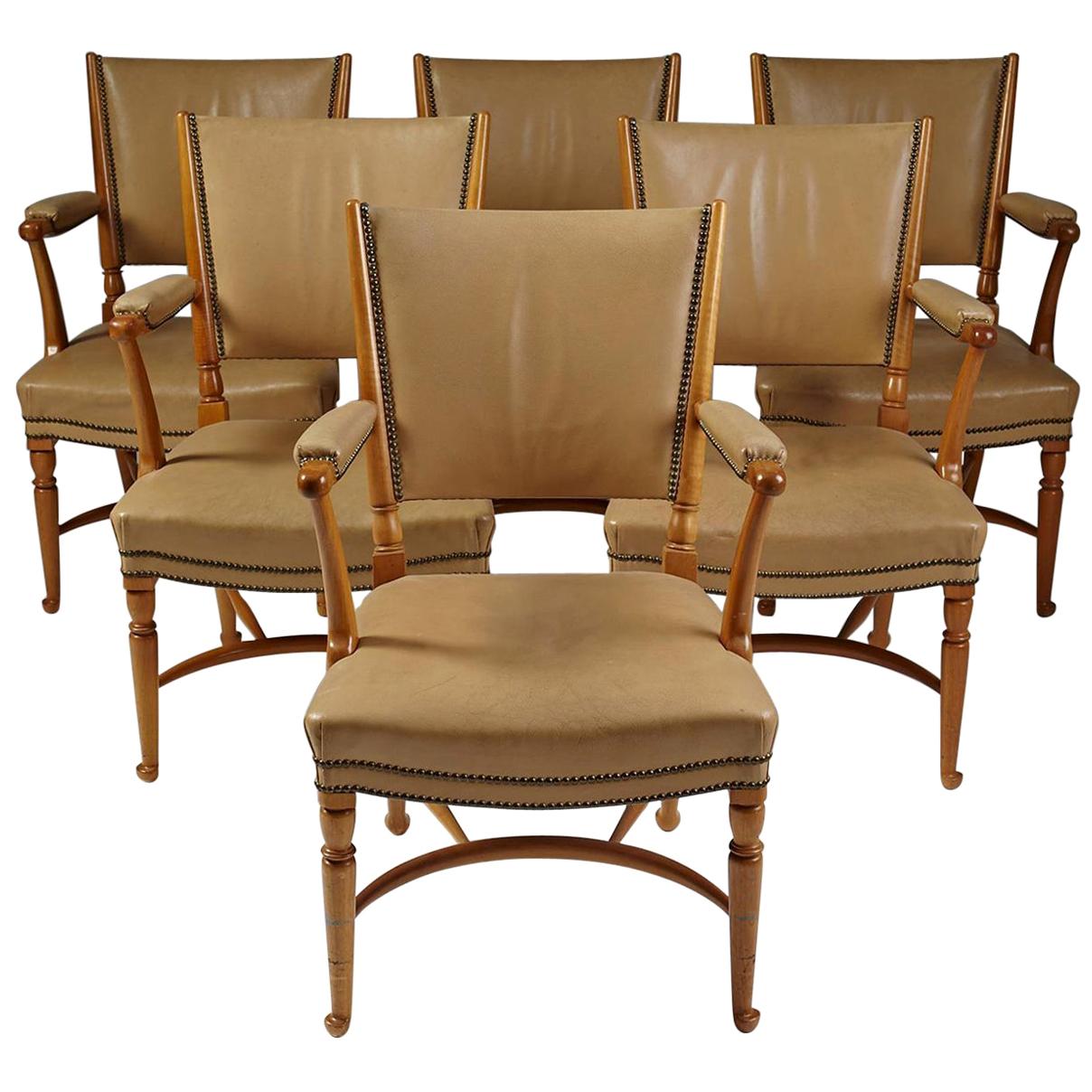Set of Six Dining Chairs Model 526 Designed by Josef Frank for Svenskt Tenn
About the Item
- Creator:Josef Frank (Designer)
- Dimensions:Height: 32.68 in (83 cm)Width: 16.54 in (42 cm)Depth: 16.93 in (43 cm)Seat Height: 16.93 in (43 cm)
- Sold As:Set of 6
- Style:Mid-Century Modern (Of the Period)
- Materials and Techniques:
- Place of Origin:
- Period:
- Date of Manufacture:1934
- Condition:
- Seller Location:Stockholm, SE
- Reference Number:1stDibs: LU1006626225932
Josef Frank
Austrian architect and furniture and fabric designer Josef Frank was a leading voice for a gentle, humane modernism. His advocacy of warm, comfortable, eclectically styled environments was highly influential in his adopted country of Sweden, and it’s now widely regarded as a harbinger of the backlash against doctrinaire modernism and the embrace of the homespun that occurred in the late 1960s.
The son of a successful Viennese textile manufacturer, Frank studied architecture at Vienna University of Technology, graduating in 1910. From the first years of his practice, he marched counter to the orderly, symmetrical architectural layouts and decors prescribed by contemporaries such as Adolf Loos.
Frank drafted rooms of varying shapes and called for flexible interior-design arrangements. His furniture pieces are light and easy to move — and his chairs are always made of wood, most often with lushly curved steam-bent arms and slatted backs. Frank openly loathed the tubular steel furnishings and “machine for living” aesthetic promoted by Le Corbusier and Ludwig Mies van der Rohe and other Bauhaus principals. “The home must not be a mere efficient machine,” Frank once said. “It must offer comfort, rest and coziness…. There are no puritan principles in good interior decoration.”
Frank — who was Jewish — sensed the dire implications of the rise of Nazism in Germany and Austria, and in 1933 he moved to Stockholm with his Swedish wife, Anna. He became the design chief for the furnishings maker Svenskt Tenn and found a perfect match culturally for his brand of simple, relaxed and bright creations. Like many modernists — notably Charles and Ray Eames and Alexander Girard — Frank had a deep love of folk art, which influenced his designs for a wide array of colorful, richly patterned upholstery fabrics, many based on the classic “Tree of Life” motif.
In all his designs, Frank took inspiration from a broad variety of sources. In his furniture, one can discern traces of Asian patterns, Rococo, Italian Renaissance, Scandinavian handicrafts and even Chippendale pieces. As such, the work of Frank — the friendly modernist — is at home in any type of décor.
Find vintage Josef Frank pillows, armchairs, floor lamps and other furniture on 1stDibs.
- ShippingRetrieving quote...Ships From: Stockholm, Sweden
- Return PolicyA return for this item may be initiated within 2 days of delivery.
- Set of Six Dining Chairs Model 2027 Designed by Josef Frank for Svenskt TennBy Josef FrankLocated in Stockholm, SESet of six dining chairs model 2027 designed by Josef Frank for Svenskt Tenn, Sweden, 1950s. Mahogany, leather and brass. Josef Frank developed his characteristic style combining e...Category
Vintage 1950s Swedish Mid-Century Modern Dining Room Chairs
MaterialsBrass
- Set of Six Chairs Model 2025 Designed by Josef Frank for Svenskt TennBy Josef FrankLocated in Stockholm, SESet of six chairs model 2025 designed by Josef Frank for Svenskt Tenn, Sweden, 1950s. Lacquered wood frame and a fabric upholstered seat. Marked. Josef Frank designed this chair i...Category
Mid-20th Century Swedish Mid-Century Modern Chairs
MaterialsFabric, Upholstery, Wood, Bentwood, Lacquer
- Set of Eight Dining Chairs Model 2027 Designed by Josef Frank for Svenskt TennBy Josef FrankLocated in Stockholm, SESet of eight dining chairs model 2027 designed by Josef Frank for Svenskt Tenn, Sweden. 1950s. Mahogany and horsehair upholstery. Together with Estrid Ericson and her furnishing co...Category
Mid-20th Century Swedish Mid-Century Modern Dining Room Chairs
MaterialsUpholstery, Mahogany
- Set of Four Dining Chairs Model 2027 Designed by Josef Frank for Svenskt TennBy Josef FrankLocated in Stockholm, SESet of four dining chairs model 2027 designed by Josef Frank for Svenskt Tenn. Sweden, 1950s. Mahogany and leather. Together with Estrid Ericson and her furnishing company, Svenskt...Category
Mid-20th Century Swedish Mid-Century Modern Dining Room Chairs
MaterialsLeather, Mahogany
- Dining Table Model 1197 Designed by Josef Frank for Svenskt Tenn, Sweden, 1940sBy Josef FrankLocated in Stockholm, SEDining table model 1197 designed by Josef Frank for Svenskt Tenn, Sweden, 1940s. Mahogany. This simple yet elegant dining table is an excellent example of how Josef Frank combined...Category
Mid-20th Century Swedish Mid-Century Modern Dining Room Tables
MaterialsMahogany
- Occasional Table Model 2168 Designed by Josef Frank for Svenskt TennBy Josef FrankLocated in Stockholm, SEOccasional table model 2168 designed by Josef Frank for Svenskt Tenn, Sweden. 1950s. Walnut and marble. Josef Frank’s occasional table “model 2168” is one of his rarer models. Its beautifully carved, turned legs...Category
Mid-20th Century Swedish Mid-Century Modern Tables
MaterialsMarble
- Josef Frank Dining Chairs Model 695 Produced by Svenskt TennBy Josef FrankLocated in Limhamn, Skåne länVery rare set of 10 dining chairs model 695 designed by Josef Frank. Produced by Svenskt Tenn in Sweden.Category
Vintage 1930s Swedish Scandinavian Modern Dining Room Chairs
MaterialsBrass
- Bentwood Prague Model 811 Dining Chair by Josef Frank Josef Hoffmann for StendigBy Stendig Co., Josef Frank, Josef HoffmannLocated in Deland, FLIntroducing a rare and beautiful single Bentwood Prague Model 811 Dining Chair by the renowned designers Josef Frank and Josef Hoffmann for Stendig. De...Category
Vintage 1960s Polish Mid-Century Modern Dining Room Chairs
MaterialsCane, Wood, Bentwood
- Josef Frank stool model 972 by Firma Svenskt Tenn, SwedenBy Josef Frank, Svenskt TennLocated in Forserum, SEStool model 972, a 1940 design by Josef Frank for Firma Svenskt Tenn. Crafted from solid mahogany, it features rich red leather upholstery and decorative brass rivets along the sides...Category
Vintage 1940s Swedish Scandinavian Modern Stools
MaterialsLeather, Mahogany
- Josef Frank stool model 972 by Firma Svenskt Tenn, SwedenBy Josef Frank, Svenskt TennLocated in Forserum, SEStool model 972, a 1940 design by Josef Frank for Firma Svenskt Tenn. Crafted from solid mahogany, it features rich red leather upholstery and decorative brass rivets along the sides...Category
Vintage 1940s Swedish Scandinavian Modern Stools
MaterialsLeather, Mahogany
- Josef Frank stool model 1034 by Firma Svenskt Tenn, SwedenBy Josef Frank, Svenskt TennLocated in Forserum, SEStool model 1034, designed by Josef Frank for Firma Svenskt Tenn. Its versatile design makes it suitable for use as both a stool and a low organic side table. Crafted from solid maho...Category
Vintage 1940s Swedish Scandinavian Modern Stools
MaterialsMahogany
- Josef Frank stool model 2009 by Firma Svenskt Tenn, SwedenBy Josef Frank, Svenskt TennLocated in Forserum, SEStool model 2009, designed by Josef Frank for Firma Svenskt Tenn. Crafted from solid walnut with vibrant red leather upholstery, it features ornamental brass rivets adorning its legs...Category
Vintage 1940s Swedish Scandinavian Modern Stools
MaterialsLeather, Walnut

